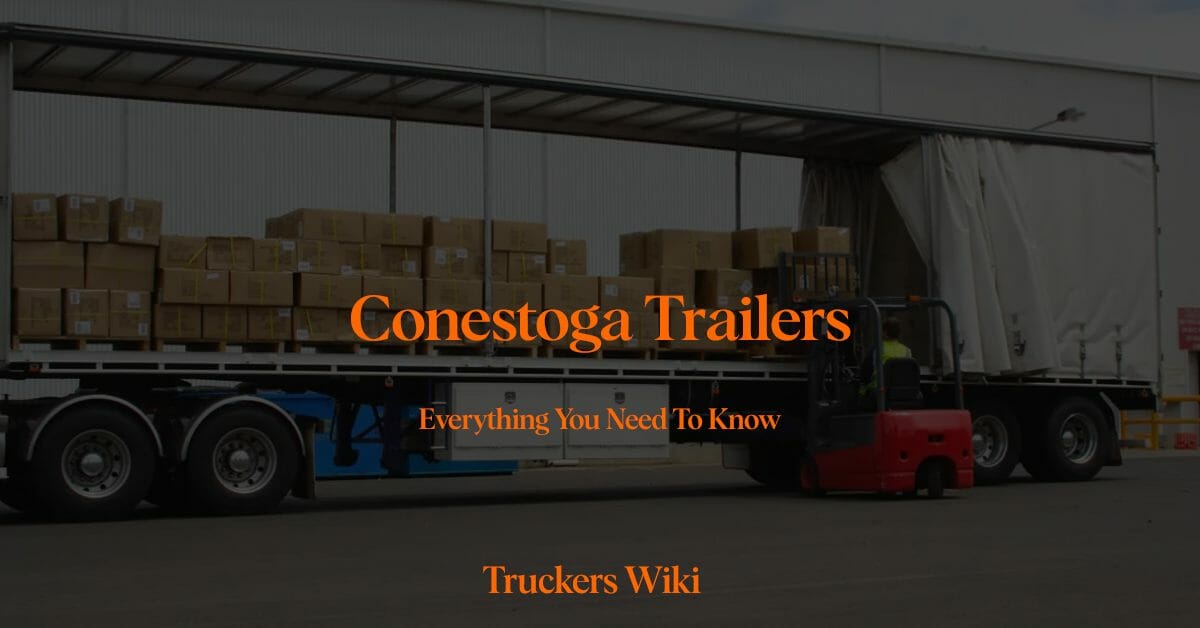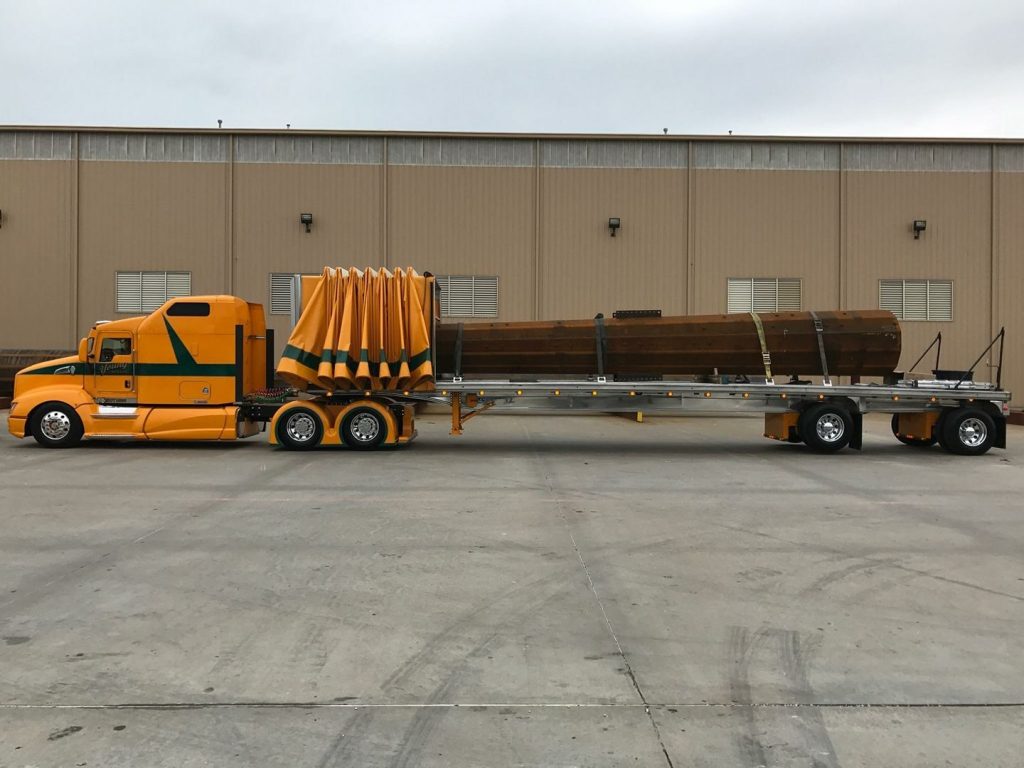
Table of Contents
What is a Conestoga Trailer
Conestoga trailer, also known as rolling tarp system is a type of semi-trailer characterized by a flexible, retractable tarp system that covers the load. This design allows for easy loading and unloading from the sides, rear, or top of the trailer, while still providing full protection for the cargo.
Types of Conestoga Trailers
Conestoga Flatbed Trailers
Overview: The flatbed Conestoga trailer is a quite popular choice in the trucking industry, capable of transporting a wide range of open-deck commodities similar to traditional flatbeds. These trailers are typically available in lengths of 48 and 53 feet.
Dimensions and Capacity of Flatbed Conestoga trailer
- Maximum Width: 8 feet, 4 inches (100 inches)
- Maximum Height: 8 feet (96 inches)
- Length Options: 48 feet and 53 feet
- Weight Capacity: Up to 44,000 pounds
- Specific Dimensions: For the 48-foot model, dimensions are 48’L x 8’4”W x 8’H. The 53-foot model extends to 53’L with the same width and height.

Step-Deck Conestoga Trailers
Purpose: Step-deck Conestoga trailers cater to taller freight that exceeds the height capacity of flatbed Conestogas, such as CNC machinery, robotics, and even helicopters, providing essential in-transit protection.
48-Foot Model Dimensions:
- Upper Deck Height: 8 feet (96 inches), Length: 10 feet
- Lower Deck Height: 9 feet, 8 inches (110 inches), Length: 38 feet
- Overall Width: 8 feet, 4 inches (100 inches)
- Weight Capacity: 41,000 pounds
53-Foot Model Dimensions:
- Upper Deck: Maintains an 8-foot height with a 10-foot length
- Lower Deck: Increases to a height of 9 feet, 8 inches (116 inches) with a 43-foot length
- Weight Capacity: Remains at 41,000 pounds
Double Drop Conestoga Trailers
Usage: The double drop Conestoga is designed for transporting heavy equipment, machinery, and other items weighing up to 36,000 pounds and exceeding 9 feet, 8 inches in height. While less common than flatbed or step-deck models, they offer a specialized solution for moving oversized freight that requires the protective cover of a Conestoga tarping system.
48-Foot Model Dimensions:
- Front Deck: 9 feet long, 8 feet high (96 inches)
- Well Space (Lower Deck): Ranges from 26 to 30 feet in length, with a maximum height of 11 feet, 7 inches (139 inches)
- Rear Deck: Matches the front deck in length at 9 feet, with a slightly lower maximum height of 9 feet, 6 inches
- Weight Capacity: 35,000 pounds
Design and Features
At first glance, a Conestoga trailer might look similar to a standard flatbed trailer. However, the unique, retractable tarp system sets it apart. The tarp, which slides on rails mounted to the trailer’s sides, can be fully opened or closed, offering versatile loading and unloading options. This retractable tarp system is designed to protect cargo from the elements, as well as potential road damage.
Conestoga trailers can accommodate a wide range of cargo sizes, with lengths generally ranging from 48 to 53 feet, and capacities up to 50,000 pounds. They typically have an internal height of about 8 feet, providing ample vertical space for cargo.
Common Uses
Due to their versatility and cargo protection, Conestoga trailers are used across numerous industries. They are ideal for transporting cargo that is sensitive to weather conditions, such as wood, steel, machinery, and automotive parts. Moreover, they are commonly used when cargo requires side or overhead loading, such as palletized goods or large machinery.
Benefits and Drawbacks
Benefits of Conestoga Trailer
Versatile Loading and Unloading: The retractable tarp system enables cargo to be loaded or unloaded from the sides, rear, or top of the trailer, offering increased flexibility.
Cargo Protection: The covered design of a Conestoga trailer offers excellent protection for cargo from weather and potential damage from road debris.
Efficiency: The ease of opening and closing the Conestoga system can save significant time during the loading and unloading process.
Drawbacks of Conestoga Trailer
Cost: Conestoga trailers tend to be more expensive than traditional flatbed trailers due to their specialized tarp system.
Maintenance: The moving parts of the Conestoga system require regular maintenance to ensure smooth operation.
Conestoga Trailer Maintenance
Here are several tips for maintaining your Conestoga trailer:
Regular Inspections: Conduct frequent inspections of the tarp system, including the rolling mechanism, to identify any tears, fraying, or hardware issues. Early detection of these problems can prevent further damage and costly repairs.
Lubricate Moving Parts: The sliding mechanism of the Conestoga tarp system should be lubricated regularly to ensure smooth operation. Use a silicone-based lubricant for the best results, as it won’t attract dirt and debris that can cause wear.
Clean the Tarp: Keep the tarp clean from debris, chemicals, and other materials that can wear down the fabric over time. Use mild soap and water for cleaning, and avoid harsh chemicals that can degrade the tarp material.
Check for Water Intrusion: Make sure there are no leaks in the tarp system where water can enter. Water intrusion not only damages the cargo but can also lead to mold and mildew on the tarp.
Secure Cargo Properly: Improperly secured cargo can shift during transport, causing damage to the interior of the Conestoga trailer. Always ensure that cargo is secured according to safety standards to prevent any movement that could tear the tarp or damage the structure.
Tarp Repair: If any rips or tears are found during inspections, repair them immediately to prevent further damage. There are repair kits available specifically designed for tarp materials, or you may need to contact a professional for significant repairs.
Frame and Structure Inspection: Regularly inspect the frame and structure of the trailer for any signs of wear, rust, or damage. Addressing these issues promptly can prevent more significant problems down the road.
Conestoga vs. Flatbed Key Differences
Key Differences
Cargo Protection: Conestoga trailers offer protection for the cargo against the weather and road debris, making them suitable for sensitive materials. Flatbeds do not provide this protection, exposing the cargo to environmental elements.
Loading and Unloading: Both offer ease of loading and unloading; however, Conestogas add the ability to load from the sides or top without the need to remove and reattach a tarp, as is often necessary with flatbeds.
Versatility vs. Simplicity: Conestoga trailers offer versatile solutions for cargo needing protection and accessibility, while flatbeds offer simplicity and efficiency for durable, oversized loads.
Cost: Conestoga trailers can be more expensive due to their specialized tarp system, both in initial investment and maintenance costs. Flatbed trailers are generally less costly and require less maintenance.
Conestoga trailers offer a unique and efficient solution for hauling cargo that requires protection from the elements or special loading procedures. While they may involve higher upfront costs and maintenance, their benefits often make them a valuable asset in the transport industry. Whether you’re shipping delicate machinery, weather-sensitive materials, or large palletized goods, a Conestoga trailer can be an excellent choice.
Learn about Flatbed trailer here.
To learn more about the types of trailers used in the trucking industry click here.
Listen to The Article Here
Conestoga Trailer Video Preview by Aero Industires
Audio Article Conestoga Conestoga Trailer trailer what is
Last modified: February 14, 2024

